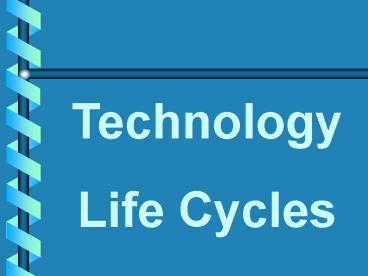Technology - PowerPoint PPT Presentation
1 / 19
Title:
Technology
Description:
Technology progresses through a 3-stage technology life cycle (TLC) ... The Diffusion-Communication-Channel Relationship. Process of Deciding to. Adopt an Innovation ... – PowerPoint PPT presentation
Number of Views:71
Avg rating:3.0/5.0
Title: Technology
1
Technology Life Cycles
2
The S-Curve of Technological Progress
- Technologys improvement of performance follow
the S-curve - Technology progresses through a 3-stage
technology life cycle (TLC) - 1. Embryonic Stage the new invention period
- - slow initial growth
- - experimentation, initial bugs worked out
3
The S-Curve of Technological Progress
- 2. Growth Stage technology improvement period
- - rapid and sustained growth
- 3. Maturity Stage the mature technology period
- - starts when upper limit of the technology is
approached - - progress in performance slows
- - technology become vulnerable to substitution
or obsolescence
4
The S-Curve of Technological Progress
Technology Performance Parameter
Physical Limit
Time
5
Technology Life Cycle and Market Growth
- Technology Development Phase
- - market does not recognize technology
- - significant amount of money on RD
- Application Launch Phase
- - slow initial growth then rapid growth
- Application Growth Phase
- - penetration depend on rate of innovation and
market needs
6
Technology Life Cycle and Market Growth
- Mature-Technology Phase
- - market volume peaks and starts to decline
- Technology Substitution Phase
- - continued use of old technology leads to
decreased revenue - Technology Obsolescence Phase
- - technology has little or no value
7
Multiple-Generation Technology
- Technology is hierarchical
- Systems consist of subsystems and subsystems
consist of components - Technology can consist of multiple technologies
- Technology can be derived from different
generations of innovation
8
Technology and Market Interaction
- Strong dynamic relationship technological
innovation and market - Science-Technology Push
- - science provides the base for technologi-cal
development which creates new market - Market Pull
- - technological development in response to
market need or demand
9
Integrating Technology Push Market Pull to
Stimulate Innovation
Innovation
Opportunities for Technology Push
Opportunities for Market Pull
- Market Demands
- Proliferation of
- Application Areas
- Recognized Needs
- Opportunities for ?
- profitability, quality,
- productivity
- Entrepreneurs
- Scientific Discoveries
- Applied Knowledge
- Recognized Needs
- Intellectual Capital
- (Scientists Engineers)
10
The Product Life Cycle
- Design and Prototype Development Phase
- Product Launching Phase
- Product Growth Phase
- Product Maturity Phase
- Substitution Products
- Product Obsolescence
11
Competition at Different Phases of the Technology
Life Cycle
- Embryonic Stage (Emerging Technology)
- - competition based on innovation
- Growth Stage
- Early part of growth stage
- - expansion in market size for product
- Later part of growth stage (Key Technology)
- - patented position, define standards
- Maturity Stage (Base Technologies)
- - Commodity available to all competitors
12
Competition in Mature Technology
- Competition no longer based on innovation but
rather on price and quality - Process innovations dominate, and assume greater
importance in achieving a competitive edge - Companies compete by introducing product lines
into segmented markets
13
Competition in Mature Technology
- Companies rely on economy of scale to decrease
price - Specialization and production efficiency within
companies assume greater importance - Only firms with dominant markets tend to survive
14
Competition in Mature Technology
- Large organizations with mature technology tend
to be rigid, bureaucratic, and multi-layered - Companies with mature technology become subject
to ? competition by those who have ? production
cost, ? labor rates ? overheads - Mature technology is continuously threatened by
substitution of newer technology
15
Diffusion of Technology is Dependent on
- Degree to which innovation offers better
advantage than does existing practice - Degree to which innovation is compatible with
values and needs of users - Degree to which innovation is considered complex
and difficult to use
16
Diffusion of Technology is Dependent on
- Degree to which innovation can be used on trial
before commitment to its adoption - Degree to which innovation seen, results observed
by potential adopters
17
The Diffusion-Communication-Channel Relationship
- Adopters of an innovation are influenced by two
types of communication channels - - interpersonal word of mouth
- - mass media channels
- Mass media influence greatest in early phase is
continuous throughout diffusion - Number of users who adopt the innovation due to
interpersonal channel expands during early phase
then decline during second half of diffusion
process
18
Process of Deciding to Adopt an Innovation
- Stage 1 Gaining knowledge of the innovation
- Stage 2 Forming a favorable opinion about the
innovation - Stage 3 Making a decision to adopt the
innovation - Stage 4 Implementing the innovation
- Stage 5 Following up on performance of the
innovation
19
Innovation Decision Time
Laggards
Followers
Leaders
Time































